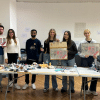At Trayport we have a Hackathon every quarter. This consists of 24 hours to hack away at something that fits within with a chosen theme. We then all come together at the end to eat pizza, drink beer (other drinks are available), and showcase what we have managed to create and vote for our favourites.

I might be biased because I organise it, but I really do think it is one of the social highlights of the Trayport calendar!
I must admit that I was a little worried when I was asked to organise one after we moved into lockdown: I couldn’t see how it would be as good. I had lots of questions… For one, would people want to join in? Also, would people be able to work together and do group projects? And finally, the one I was most worried about: did people only come to watch the demos in the office because they were promised pizza?!?
We announced the Hackathon the week before it was due to start with the rather appropriate theme of “Improving the working from home experience”. We have a Hackathon chat channel and we used that to try to spark ideas and build some hype, replacing some of what would have happened naturally had we all been working in the same office.
Overall, we had around 15 projects demoed and plenty of other people who joined in. Some were maybe a little too ambitious to be able to get something ready and “demo-able” in the 24hour timeframe.
How Did People Work Together?
One of the main things that had to be worked out was how teams would manage to hack together remotely. One of our winning teams (who created a replacement scrum-based game to replace the foosball they would usually play after stand up) had 6 people working together on the same app! This is quite a feat, as anyone who has tried to coordinate work on the same code base would tell you.
They started by gathering ideas in Google Docs: jotting down bullet points on what the app should look like and what it should do, before creating prioritised to-do lists to work through.
For the actual coding, they split into three teams: front end, back end and game logic. They connected to the same VSCode liveshare session, meaning they could instantly see what others were doing. It also meant that the code was always up to date, and didn’t rely on someone to committing it to a common repository. Port forwarding from the local machine to all liveshare participants also meant that everyone involved could test the game instantly.

To keep communication flowing throughout the day, they had a Google Meet room for each sub-team and an extra one for the whole team (which was muted and only used for any burning questions!). They topped this off by having a small standup every 30 minutes or so to check in on progress and to rotate the teams as required. They didn’t use a chat channel as this would be too slow for the speed required for a Hackathon.
The Demos and Our Hacka-App
Despite the challenge of a remote Hackathon, the demos ended up being a great success!
One of the stars of the show, as always, was our very own Hackathon app. Yes, we do take this very seriously. What started off as simply a way to move voting away from the slow and un-anonymous voting on a whiteboard in the office, has turned into the real tour de force of the Hackathon demos! Without it, I don’t think that the demos would have been half as fun.

The app was designed as a ‘second screen’ mobile app using a React Frontend completely hosted on azure. It allows people to register the project they will demo, allowing audience members to follow along with the demos on the app, marking off their favourites or adding emoji reactions. These updates are pushed out live to everyone on the app using signalR.
The Hacka-app generally gets expanded in every Hackathon and for this one a chat functionality was added. This meant we could discuss the demos live, giving the vibe that we were all in the same room watching together.
I think the ability for the audience to chat and react immediately to the demos really helped make the demo feel more interactive. Along with giving a round of applause at the end of every demo and allowing questions, it made the whole event engaging and enjoyable.
And for those of you still wondering, it turns out people aren’t only in it for the pizza. We had almost 100 people tune in to watch over our London and Vienna offices, with loads of positive feedback.
So if you’re looking for something to do over this lockdown time, I would definitely recommend a Hackathon!



